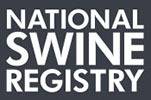With the spring showpig sale season winding down, most of us have time to take a quick breath before plunging into show season. (If you’re not in the field, that is.) In the NSR Marketing and Communications Department, we’re using this break to catch up on paperwork, prepare for the next issue of Seedstock EDGE and start re-designing our website.
I’m sure many of you will be sending show and sale results off to your web designers. But before you do, put your site through the paces and see if it passes these tests highlighted in Steve Krug’s Don’t Make Me Think (a fast, surprisingly entertaining read on web usability):
- Don’t Make Me Think (or anyone for that matter) – Surfing the web should not be a critical thinking exercise and neither should navigating your website. Ensure that visitors to your site don’t have to think by making your site navigation clear. Anything “clickable” should be easy-to-locate and obvious. If it is a button – make it look like a button.
- Scan Friendly Text – When was the last time you read a web page? No, I mean REALLY read a web page. If you can’t recall, you can join the majority of web users. The instant satisfaction of the Internet lends itself to short bits of text, known in the communications world as “copy.” The easier your copy is to scan, the more effective your message is. So use headlines, bulleted lists and paragraph breaks to organize your information according to its relevance and importance.
- Pass the “Trunk Test” – In Krug’s book, he talks about the “trunk test.” To perform the trunk test, go to any page on your website and pretend you were just dumped out at that page from a search engine – or for the analogy’s sake, you were just let out of a car’s trunk at this site. Would you know where you are? How could you get back home? Make sure your site has “signs” and breadcrumbs (those little words with the arrows) so your users can find their way home. Navigating a site should not be an adventure like Homeward Bound, which is why every page of your site should include the site name, a button to get home and a clear navigation menu.
- Home Sweet Home – Speaking of home, Krug says the home page should convey the “big picture” without overwhelming the user. Now, we know we’re guilty of overwhelming you with the amount of information on our homepage. So we’re taking our own advice, and Krug’s, and removing everything we think we can place elsewhere. The homepage is best suited for a welcome note and a company tagline – the rest is up to your user-friendly navigation.
I hope these four quick tips will help you improve your web presence. I know that we will be working hard for the next several months to improve ours. As always, if you have any ideas for us or need some marketing insight,feel free to get in touch with us.
Best,
Katie


